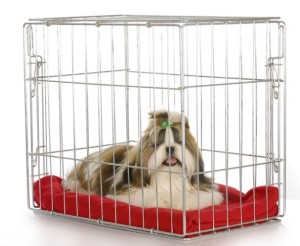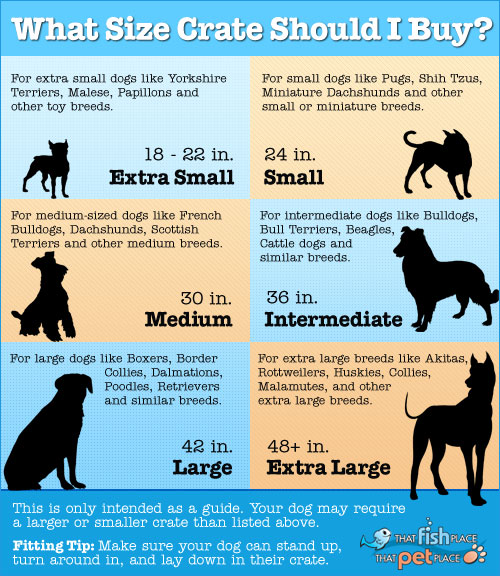 Crate training can be a challenge for many pet parents. The first thing I often hear is that they feel bad leaving them in a crate while they are away instead of letting them have a place to roam and sleep on the couch. Crate training doesn’t have to be a negative thing, in fact, it should be your pet’s favorite place to be… that is if you’ve done your crate training the right way. This is the first of a series of posts about crate training, so lets start with the simplest question to answer: why should I crate train my puppy? P.S. if you can’t wait for the rest of the series of articles, I’ve written a comprehensive guide on crate training available on thatpetplace.com.
Crate training can be a challenge for many pet parents. The first thing I often hear is that they feel bad leaving them in a crate while they are away instead of letting them have a place to roam and sleep on the couch. Crate training doesn’t have to be a negative thing, in fact, it should be your pet’s favorite place to be… that is if you’ve done your crate training the right way. This is the first of a series of posts about crate training, so lets start with the simplest question to answer: why should I crate train my puppy? P.S. if you can’t wait for the rest of the series of articles, I’ve written a comprehensive guide on crate training available on thatpetplace.com.
Does my dog need a crate?
Lets go back to a time before dogs evolved into, well, domesticated dogs. Wild dogs, foxes and wolves all have a den in the wild. They are all relatives and in the wild have many of the same behaviors. A den acts as a dog’s safe haven. It is a place to retreat to when they are frightened, feel threatened, where they go to eat, and where they raise their young.
In your home your pet’s crate becomes their den. If you follow the right steps the crate becomes your pet’s safe haven, retreat and home within their home. Scared of thunderstorms? Lay in the crate and feel comforted. Too busy in the house with guests? Retreat to the crate for some rest and relaxation. Fearful that your sister is going to steal your bone? Take it into your crate and feel safe. You can see where I am going, right?
A second reason to crate train is one every puppy parent can relate to: Housetraining. If you have your puppy housed in a properly sized crate while they cannot be supervised, potty training your dog will be a smoother process. They key words were “properly sized crate”. The crate should be large enough to stand up, turn around and lay down comfortably inside. Any larger and your pup will chose one end to relieve themselves and the other end to nap and play.
I know what you’re thinking: If my crate is the size of my puppy, will I have to buy multiple crates as he grows up? The answer is no! Fortunately in recent years manufacturers have developed adjustable crates! There is a panel that can be moved front and back to resize your crate as your puppy grows into their adult sized crate. Typically they are made of wire and come with many crates. If you don’t have an adjustable panel you can make a makeshift one out of a big blanket or pillow.
Crate training also keeps your curious puppy safe while they are unsupervised. I’ve heard too many stories of dogs who have accidentally gotten stuck in things, chewed through cords or ingested dangerous substances or objects while not properly supervised. Puppies are like toddlers in that they will put anything they can into their mouths. Their mouths are like our hands – it is how they explore their new world.

Lastly, having a crate trained dog makes kenneling, boarding, grooming and even vet visits less stressful on a dog. How, you ask? So glad you did! If your dog is used to being in a wire crate or enclosure they’ll be less stressed out than a dog who was never crate trained who is put into an enclosure when they go away. Most groomers use crates to keep order amidst chaos, vets use crates before and after surgery and for observation. Some boarders use crates or crate-like enclosures overnight or even most of the day when they aren’t out for
scheduled play or walks. Imagine it from your perspective. You’re an adult and have never heard of or been inside an elevator. You are then ushered into an elevator in the empire state building. The doors close and you have no idea what is going on! Are you trapped? How long will you be in this box? It would cause anxiety for sure! You’re human so someone could explain it to you and you could comprehend. A dog doesn’t understand English, no matter what you may think. How do you explain that the crate is a temporary restriction and reduce anxiety? Crate training. Learning to associate a crate with a nice, happy place is the only way I know how to do this until the human-dog language barrier is broken!
That’s all for this segment. I’d like to leave you with just a few pointers to keep in mind while you investigate crate training. I wish you all the best in your endevors. If you’ve got any crate training tips you’d like to share with us please submit a comment – we love to hear from our readers. Thanks for reading!
Important Tips for Crate Training Made Easy
• Make the crate enjoyable, fun, comfortable and safe place to be every time they’re in it
• Stuffed Kong dog toys are perfect to keep dogs and puppies occupied while they are in the crate. (Please note: be sure to buy the correct size Kong and supervise your pet the first few times they have one to make sure they can be trusted alone with the toy. Some dogs are strong enough chewers to break off chunks and choke or cause internal blockages.)
• Go for a long walk or run before asking them to stay in their crate for a long period of time to tire them out so they are relaxed in the crate.
• Move slowly through the crate training process and you’ll be rewarded with long-term success. This process may take days or weeks and requires constant reinforcement to get it right.
 That Pet Blog That Pet Place Pet Blog
That Pet Blog That Pet Place Pet Blog


I’m gone to tell my little brother, that he should also pay a visit this wblog on regular basis to get updated fom latest
reports.
Excellent! Thank you Florine 🙂